Garcia Frankowski is a creative practice formed by Cruz García (San Juan, 1983), architect, artist and writer from Puerto Rico graduated by the University of Puerto Rico, and Nathalie Frankowski (Dundee, 1985), architect, poetess and artist graduated by the Ecole French Nationale Supérieure d’Architecture of Paris La Villette.
In 2008 they both founded in Brussels WAI Architecture Think Tank, a workshop of architectural intelligence. Simultaneously as Garcia Frankowski collective art they start the production of writing, designs and publishing works among which we would like to highlight the magazine What About It? (WAI Think Tank Publishers), Pure Hardcore Icons (Artifice Books, 2013), Narrative Architecture (2014) and numerous essays and manifestos in critical known magazines as MONU Magazine on Urbanism, Conditions, Volume, Pin-Up, Crossroads, Horizon, Studio and Zawia. Becoming an interest of international scope, the work of Garcia and Frankowski has been exhibited in multiple cities around the world, and now his work is displayed at the MOMA.
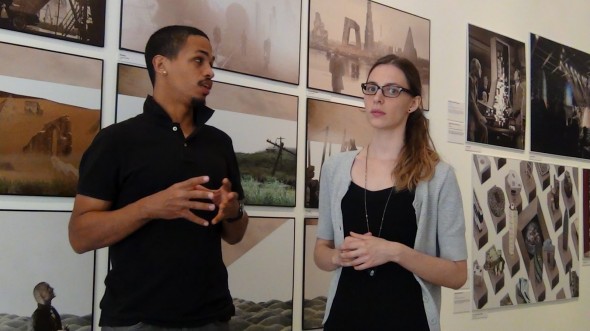
On the occasion of the newly launched “Shapes and Text Islands” book in Book-a, we have had with Garcia Frankowski this conversation about their work and motivations:
What does WAI Architecture Think Tank mean to you, and what is its relationship with the work that you identify as Garcia Frankowski’s?
WAI Architecture Think Tank is a platform that was conceived with the intention of contributing to the collective intelligence of architecture, through publications, exhibitions, essays, images, narrative architectures, urban plans, buildings and any other tool with potential. WAI, which is an acronym for What About It? and Workshop for Architectural Intelligentsia, is a concept that allows us to ask critical questions through each project. Through WAI we can question the status quo of the discipline. We can assume the risks and responsibilities that are inherent to architecture, if it’s thought as an artistic, technical, intellectual, and social exercise. The only constant in WAI is the critical attitude towards architecture.
If WAI gives us freedom within the limits of the discipline (limits that are yet to be defined), there’s another type of production that is detached from the direct influence of architecture: the work that we do and sign as Garcia Frankowski. With this work we ask ourselves about the potential of art in its pure form, be it through painting, object making, poetry, or creative literature. This type of work lets us reflect on the role of concepts that go beyond buildings and cities.
Through Garcia Frankowski we look to ask other types of questions that cannot be answered only by architecture and its multiple ramifications, and based on a dialogue with the history of art, with ourselves and with whoever reads or observes us.
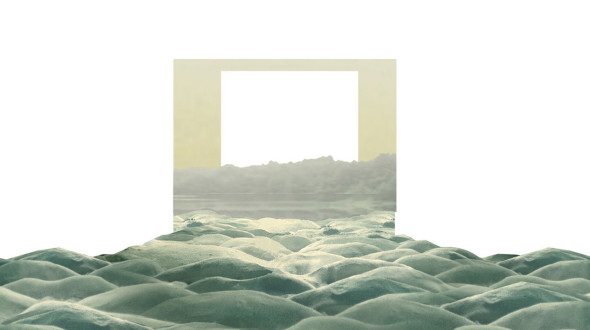
How did the idea of publishing the WAIzines (What About It?) come into being?
The WAIzines (What About It? Part 1 and Part 2) are one of the tools that come as part of the WAI mission to contribute to the collective intelligence of architecture. Graphic Narratives in magazine format, the WAIzines allow us to engage in a dialogue with readers to whom we present our research, visual provocations and interviews with artists whose work is valuable and influential. The WAIzines don’t fall into the mould of commercial periodical publishers. They have no specific topic or advertisements and their publishing dates are not periodically predetermined. Once considered having enough quality material to produce an issue, we gather it and make it public, either through the numbered publications or for free through internet. In a way the WAIzines are one of the windows that allow us to engage in a dialogue with the rest of the world. This is why they exist through different platforms.
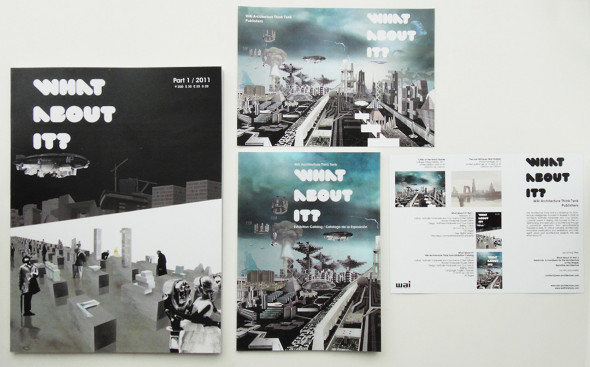
We would like to congratulate you on the project Cut ‘n’ Paste, whose curator is Pedro Gadanho and is currently exhibited in MOMA. You also have new expositions in the light, could you tell us about them?
We have several exhibitions with which we have been working in recent months. On the one hand the WAIzines, which remain on display through October at the Vitra Design Museum in Weil am Rhein, as part of the sample Archizines Exhibition, which also can be seen from September at Fundação Serra Henriques, in Lisbon.
On the other hand the work of Garcia Frankowski will be exhibited in late August in the CU Space of 798 Art Zone in Beijing, with Walls, Islands, Frames, Mirrors Exhibition, and by the end of September, in the same city, in the Beijing Design Week, with Pure Hardcore Icons Exhibition Manifesto.
Each exhibition, every essay, every magazine, every drawing is a step in a long road ahead. The exhibition at the MoMA presents work in an institution with great media reach, alongside the work of other architects or artists with great projection. However, for us other exhibitions or publications that could pass almost unnoticed are equally important. We appreciate every opportunity, however small or large, to present our work, or to start a dialogue or discussion.
Let’s talk about the Intelligentsia collection you have just launched in Book-a. What is the aim of this collection? How do you imagine its materialization?
The Intelligentsia Collection presents a selection of our graphic and literary production. The first project gathers a series of works with aesthetic and conceptual autonomy. Each volume of the Intelligentsia series will respond to the specific conditions of its content. In this case, the first of the series is a manifesto of Garcia Frankowski, so it will make special emphasis on the unpublished works that are part of our most intimate repertoire.
Intelligentsia is born as a collective of artists or intellectuals whose work defies the status quo of the traditional disciplines. Intelligentsia is an ideal. It is our ambition: to function as an artistic and intellectual intelligentsia, while we defend the values and the spirit of the international avant-garde. The concept of Intelligentsia aims at capturing our intention to produce tools that could contribute intellectual and aesthetic values capable of transcending time and place.
It raises our interest the use you give to the “Manifesto” format (as shown in the latest issue of Volume magazine or as the title that is currently campaigning here in Book-a) as a means of expressing your concerns? What does it mean to you to recover the Manifesto format in a contemporary context?
The manifesto is perhaps one of the purest and most direct forms in which a group of artists and thinkers can express their intentions. For better or worse, the manifesto has been linked to the history of politics and art in the twentieth century. We believe that the manifesto is an essential tool that allows us to fight the epistemological obscurantism discourse of contemporary art, literature and politics inherited from postmodern philosophy. The manifesto is a way to simplify ideas and clearly define objectives. This is why much of our efforts are aimed at making manifestoes, from the manifesto of pure form in architecture, Pure Hardcore Icons, to the “foam” manifesto of WAI, to Narrative Architecture manifesto (published in the latest edition of the Dutch magazine Volume), or the manifesto of Garcia Frankowski that we are working on for this collection.
Poem of the Shapes: Garcia Frankowski from WAI Think Tank on Vimeo.
We have noticed that you have a great versatility when producing your work and in that you use very different expressive mediums: publications, painting, video, poetry, texts … What leads you to decide to use a particular means of expression for each project and what relationship exists between the different mediums? For example the recent video published on Volume, “Blindness”, has many reminiscences with your paintings…
Each tool or method of representation has a characteristic potential to express ideas or concepts. What can be said in words hardly can be painted and vice versa. At the same time, this generates a friction between ideas and mediums that motivates our work. We are interested in visual poems, texts in painting, architectural narratives, texts that challenge the limits of our thinking, the construction of ideas and how these are manifested through different tools.
It is worth noting that not only are these various tools our principal source of inspiration; and although these sources are diverse (music, film, painting, philosophy, literature) there are many authors whose imprtant works are essential to our work, thinking and to the positioning of our practice. That’s why we make references to people like Wittgenstein, Tarkovsky, Garbareck, Saramago, Sloterdijk, Orwell, Palermo, Malevich, Tati, West, Marker, Camus or Houellebecq.
In line with works like Pure Hard Icons Manifesto, you have expressed the desire to bring back form as a topic of discussion for architecture. You have also observed that form has remained a taboo subject in the theoretical discourse of architecture, despite the prominence it has in the media. But contemporary visual culture seems to have reduced the complexity that the avant-garde of the early twentieth century granted to form; a form linked to abstract aesthetics. How do you position your recovery of form between these two poles (seduction and reduction vs complexity and transcendence)? What are the questions you are interested to mobilize concerning your work on form?
The Pure Hardcore Icons Manifesto was created as part of an effort to develop tools, methods and strategies that could help us shed light on the condition of contemporary architecture. The project is a response to a theoretical laissez faire and the lack of attention to issues inherent to architectural production. We have seen through the years how architects have decided to exchange architecture for issues that often lie beyond their control. One day they speak with nostalgic fervor about the city, while another day they are analysts of the “countryside”. Either they fill books with the empty jargon of postmodern philosophies, with insipid cartoonesque diagrams full of arrows, or with sterile images of impossibly blue skies and flocks of happy birds.
Architectural discussions, especially those that claim to be the product of “research” or the so-called “research architecture” often end up being reductionist interpretations using the mass media as a broadcasting platform. Slaves of glamour, the flash of cameras and the brightness of couche paper the architect adopts any position for the sake of being on the crest of the wave. In that sense Pure Hardcore Icons is simultaneously an exhaustive analysis of a taboo subject and also a provocation aimed at a discipline that has chosen to not assume its intellectual responsibilities. Because, how is it possible to deny protagonism to form when it’s obvious that it has been, if not the key, one of the strategies that had made architecture what it is today? We do not intend to make form the ultimate architectural ideal. Nor do we see ourselves as formalists. This whole project it’s about being honest with the discipline and providing tools to contribute to its collective intelligence.
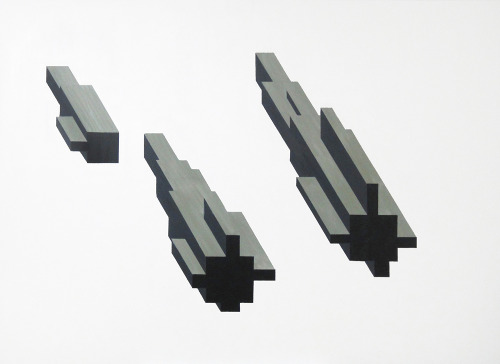
Study No.2 Islands. 160cm x 120cm 63″ x 47 1/4″. Oil on Canvas, 2012.
This explains one of our interests in form in architecture, at least in its intellectual or theoretical formulation. As for the non-architectural work we do, there’s another interest in form as pure essence, and for what it represents both as a significant, and in its aesthetic, historical, and cultural properties. We believe that geometric forms have, in their symbolic function, the potential to communicate ideas, whether they are archetypical, in the sense given by Carl Jung in his work on the collective unconscious, or acquired within a socio cultural framework. In fact, the interest we have in geometric form is shared by the interest we have in language and the use of words as codifying elements.
There is a tension we want to explore between preconceived ideas of form and text and how these can be used to challenge pre-established concepts. What plays a significant role here is the essay we are writing for the upcoming publication that explores the idea of language as a determinant mediator of ideas by studying the concept of “Newspeak” presented by George Orwell in his novel 1984 (1949), and the work on language explored by Ludwig Wittgenstein in the Tractatus Logico Philosophicus (1922). In short, every project, whether architectural through WAI or artistic through Garcia Frankowski gives us a new opportunity to understand concepts such as form, language and symbolism from various perspectives and through different mediums (text, painting, collage, mixed media).
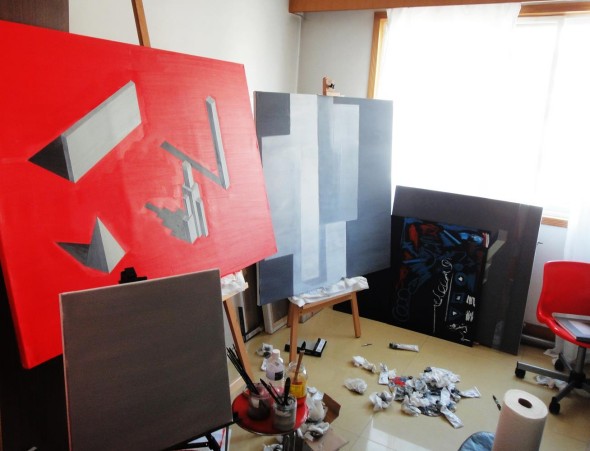
Your paintings seem to reverberate the renewing art movements of the early twentieth century, especially constructivism. Your Prouns in particular, seem like a homage to El Lissitzky. On the other hand, in your Narrative Architecture Manifesto for a critical attitude towards defending an ideology and ambitions…
It is worth noting that it is precisely to El Lissitzky that the Projects for the Affirmation of the New seem to be talking because we consider that he managed to transcend the propagandistic impasse of the Constructivists and incorporated the transcendental attitude of the Suprematist. We have no interest in political slogans and much less in the oversimplification of utilitarian art.
We are interested in the attitude adopted by those who knew how to get away from the political fanfare so characteristic of the great political movements in the 20th century. This does not mean that we don’t have a political position, but that art is not reduced only to this topic. Also, we must affirm that our architectural project is guided by a concept that might not necessarily apply to our purely artistic work. It may seem difficult to discern, even for ourselves, but they are two activities whose relationship is yet to be discovered.
Our paintings, even if they are able to reverberate in one way or another in our architectural projects, are not architecture and may not have any architectural message behind them. They are islands floating on canvases, projects that arise as plastic experiments and critical questions from other conceptual spheres. These projects stem from concepts that are different to the ones we explore in our architectural works. We do not paint to justify architecture or vice versa. They are different mediums of action.
But your own project, as the staging of a generalized condition –the impasse of criticism and theory—is, in your own words, “ostensibly heroic”. Is this ambition or heroism a choice or an induced component required for the exercise of establishing a critique of ideology? Can humor, irony and sarcasm –to which you give an important role in your Manifesto for a Narrative Architecture—be an antidote or short-circuit?
The Manifesto for a Narrative Architecture emphasizes the responsibility we have of unmasking ideology in architecture. Narrative Architecture is a kynical tool. We use this concept taking into reference the work of Peter Sloterdijk in his Critique of Cynical Reason (1983) to explain the difference between contemporary cynicism (an attitude that seems to be saying “they know what they are doing but they are still doing it”) and kynicism that aims at unmasking ideology by alluding to the subversive characteristics of humor and satire in order to reveal the absurdities of its statements. Narrative Architecture is an element that has been unutilized by the architectural discourse at large, to a greater part because it has not been understood in its full potential.
On numerous occasions the projects of Narrative Architecture in the 20th century have been seen as naive ‘utopias’, when in reality they are specific attacks on the discourse of the discipline. The manifesto affirms the role of Narrative Architecture in shedding light on the lies, the half truths, and the smoke screens that afflict architecture in its different spheres, from the academy, to the practice and its theory. Narrative Architecture is not an antidote, but the diagnosis of a condition. When we affirm that “Narrative Architecture doesn’t shoot down the banners and slogans of architectural discourse, it reads them aloud against the ideological wind so as to reveal their absurdity”, we mean that once identified as the condition of ideological cynicism, we can do something with it. To summarize, we can say that Narrative Architecture is just a beginning.
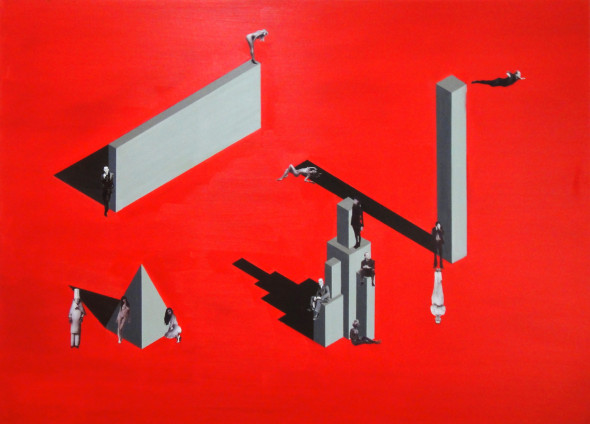
The Exhibition “Main Hall”. 140cm x 100cm 55″ x 39″. Oil and Collage on Canvas, 2012.
One of your most frequent tools is the “collage”: the hybridization, assembly and the crossing of references, concepts, cultural imagery, expressive mediums, even disciplines … Yet, you defend the autonomy of the theory of architecture. Don’t you think there is some conflict or tension between these tools and your positioning? I mean –from its cultural genealogy—collage and remixing are tools or techniques that lead to opening and / or leakage, while autonomy is presented as a means of self-assertion…
The fact that we defend the autonomy of architectural theory does not imply a limitation of its tools and strategies of representation, but rather the opposite. We even argue for a variety of tools when presenting critical positions within the discipline. The hybrid nature of the collage can generate images capable of challenging preconceived notions of architecture, as evidenced in the role it played in the Narrative Architecture proposals in the twentieth century. Those seductive images of continuous monuments and cities contained within walls, shook the foundations of the theory of architecture precisely because of the narrative potential of the collage, especially when it is used as a critical weapon.
The theory of architecture may become autonomous only when the cultural, social and intellectual framework where it has been formulated has been understood. It is only by an effort to gather intelligence through various means of action that architecture can be consolidated as a discipline capable of regenerating itself and staying updated through self-criticism. We must also remember that the collage is, like text, just a tool that acquires or loses validity depending on its content.
Finally, we would like to know what has it meant for you the experience of living and working from a creative powerhouse, and in continuous transformation as China? We are interested in how your work affects the city in which you reside, Beijing.
Although it might sound clichéd, we feel that we and our work are part of our experience in the world. In that sense it has as much effect on what we do as has our relationship with other places such as Roanne, Paris, San Juan, Brussels, Amsterdam, Dundee, or any city that becomes part of our “psychogeographical map”. We feel that our work can belong anywhere and that it can be understood by anyone interested. Our subjects rarely deal with a particular place. Of course, the experience of living in Beijing these critical years of our youth is very important, but we would not say that our work is defined by this.
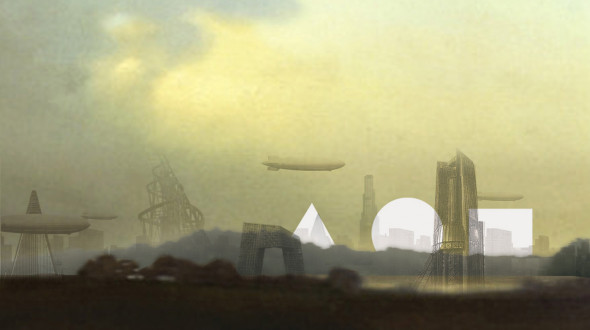
Seville / Beijing August 2013.
We invite you to visit the virtual gallery Intelligentsia of García Frankowski.
More on the artist book “Islands, Shape, Text” here.
